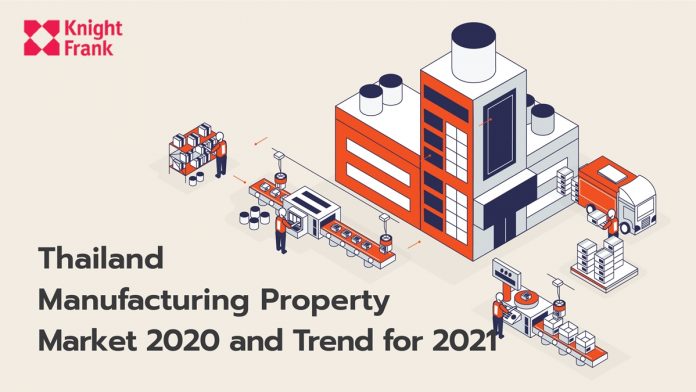Mr. Marcus Burtenshaw, Executive Director and Head of Occupier Services and Commercial Agency (OSCA), Knight Frank Thailand, said that “Global manufacturing supply chains faced unprecedented disruption in 2020 caused by lockdowns and factory closures as the world struggled to contain the pandemic. These disruptions highlighted the extent to which many countries have become increasingly reliant on production bases in countries like India and China for critical goods, prompting several governments to announce schemes that they hoped would encourage their business communities to manufacture closer to home.
Yet, this has not led to the widely expected influx of FDI to Thailand. This is because travel restrictions have not only affected the tourism sector but have also directly led to major FDI project cancelations and postponements. Relocating a factory from one country to another is not straight forward, and few would ever dare to purchase real estate without inspecting. But this is only part of that story as factories rely on supply chains that can be extraordinarily complex. Producers can often have a complex tiered web of suppliers, with many firms in each tier. So, when relocating, a whole new network of important supplier relationships will also have to be made. Much of this work today can be done remotely, but there is still no good substitute for physical inspection or the trust that can be forged in a face-to-face meeting and as such, we don’t expect to see a rebound in FDI to Thailand until global travel restrictions ease.”
Serviced Industrial Land Plot Market Indicators

Economic Overview
In Q4 2020, the GDP of Thailand declined by 4.2% Y–o–Y, improving from a 6.4% contraction recorded in the previous quarter. For the full year, the Thai economy contracted by 6.1% after it had expanded by 2.3% in 2019.
The Thai manufacturing sector plunged in the first half of the year but demonstrated positive signs of recovery in the second half. The Manufacturing Productivity Index (MPI), which dropped to a 5-year low at 79.52 points in May, has steadily recovered to reach 97.61 points in December. Nevertheless, the current level is still down 2.0% from December 2019. The recovery in the second half of the year indicated that the industrial sector has improved steadily due to better control of the COVID-19 pandemic and government measures to stimulate the national economy. Meanwhile, the amount of Foreign Direct Investment (FDI) approved by the BOI fell for the fourth consecutive year, dropping by 19.2% Y-o-Y to 361 billion baht. Most of the investment value approved is in Metal Products and Machinery (31%) followed by Services (25%).
The number of new factory operations in Thailand continued to fall, dropping by 17% from the level in 2019. In addition, the number of existing factories that expanded operations also declined by 39% to 690. On the other hand, the number factories that ceased operations fell by 58% to 716. Overall, this indicates that the factory market size remained relatively constant as there was limited activity, both expansionary and contractionary.
Serviced Industrial Land Plots (SILP)
Supply
In 2020, the total amount of serviced industrial land plots (SILP) for sale or lease, which is land made available for sale or lease in industrial estates, zones and parks, grew by 3% or 4,693 rai to a total of 169,465 rai. The growth in 2020 represents the largest increase in SILP supply over the past 5 years.
Figure 1
Thailand Serviced Industrial Land Plots Available For Sale / Lease
Rai

Figure 2
Thailand Serviced Industrial Land Plots Distribution By Region

Table 1
Thailand Serviced Industrial Land Plots Distribution By Region
Rai

Table 2
Thailand Serviced Industrial Land Plots Distribution By Region
Rai

Demand
As poor economic conditions and cloudy global and domestic investment sentiment were prolonged, 1,645 rai of SILP were sold or leased in 2020. This represents a 29% decrease from the previous year. In comparison, over the past 5 years, an average of 2,427 rai of industrial land sold or leased annually. The Eastern Seaboard continues to be by far the largest driver of demand growth in the SILP market. In 2020, 1,227 rai of land was sold or leased in the region, representing 75% of transaction activity over the past year. However, the amount of land transacted in the region dropped by 30% over the same period. Only 418 rai was sold or leased when the EEC is excluded. Atypically, a relatively large amount of land was transacted in the Northern region as 202 rai was sold or leased.
Figure 3
Thailand Serviced Industrial Land Plots Sold / Leased By Region

Given that new supply outpaced the total amount of land sold or leased, the market occupancy rate fell to 79% from 81%. The region with the highest occupancy rate is still the central region at 89%, despite the rate dropping by 4%. Meanwhile, the occupancy rate of SILP in the Eastern Seaboard fell by 0.5% to 78%. The Northern region experienced a 6% increase in the occupancy rate because of the low supply base and the relatively large amount of land transacted this year.
Table 3
Thailand Serviced Industrial Land Plots Occupancy By Region

Asking Prices
Despite the current economic slowdown and subdued transaction activity, the average asking price for SILP continued to rise. The market average rose to 5.3 million baht per rai, representing a 5% increase. In comparison, the 5-year annual increase is around 4%. The average price increased by the greatest amount for the Eastern Seaboard, rising by 6% to reach 6.0 million baht per rai. The Bangkok Metropolitan and Central regions also recorded strong price growth. The asking price in the 2 areas increased by 5% and 4% to reach 9.4 million baht and 4.8 million baht respectively.
Figure 4
Thailand Serviced Industrial Land Plots Average Asking Price
Baht Per Rai

Table 4
Thailand Serviced Industrial Land Plots Average Asking Price By Region
Baht Per Rai (Million)

Figure 5
Thailand Serviced Industrial Land Plots Average Asking Price Spread
Baht Per Rai

Outlook
The manufacturing property market was subdued in 2020 as the COVID-19 pandemic continued to disrupt global supply chains and slow the domestic economy. Early hopes of recovery were dashed following the 3rd and most severe wave of the COVID-19, which has negatively impacted domestic spending and the recovery of international travel. The Bank of Thailand recently slashed its economic forecast for 2021 to a 2% growth baseline from its previous estimate of around 3%. As predicted, the increasingly interconnected nature of the supply chain meant that the impact of pandemic on the manufacturing sector was not limited to the domestic situation. Examples of knock-on effects from COVID-19 to Thailand’s trade partners include the global shipping container shortage, which restrained trading activity even when the production of goods ramped up. In addition, international investors are still finding it difficult to enter the country so many investment projects remain on hold. For these reasons, we forecast that SILP transaction activity will remain relatively limited throughout 2021 as well.
Nevertheless, there are still many positive signs of growth for the Thai economy, for the manufacturing sector and for manufacturing property markets. Indicators such as the MPI and merchandise exports continued to improve in line with the expansion of trading partner economies. Concurrently, the Bank of Thailand views the procurement and distribution of vaccines in an adequate and timely manner as the most important issue for the Thai economy. If the distribution of vaccines proceeds as planned, demand should pick up rapidly as international travel restrictions will be lifted and subsequently, investors will be able to carry out investment projects.
There are also ample opportunities for the manufacturing property market in the medium to long term. An increasing number of companies are relocating or expanding their manufacturing bases out of China to reduce risk and diversify their supply chains. Good infrastructure, a centralized location in the region and incentives offered by the BOI will make Thailand even more attractive to international investors. In addition, the upsurge in demand for health-related goods, medical supplies, and packaged food seems to be a mainstay feature rather than a short-term trend as businesses and consumers continue to give greater priority to health and wellbeing. The promotion of Thailand as an international hub for medical goods and services should continue to be explored, given the strong public health credentials and infrastructure already in place. In 2020, the BOI made the medical cluster a priority and greenlighted several FDI deals in medical equipment production. It has also offered tax incentives for companies commercializing local research in medical devices. Signs are promising as in Q1 2021, the value of medical – related foreign investment projects seeking BOI approval jumped by 11,419% Y-o-Y to 18.4 billion baht.















